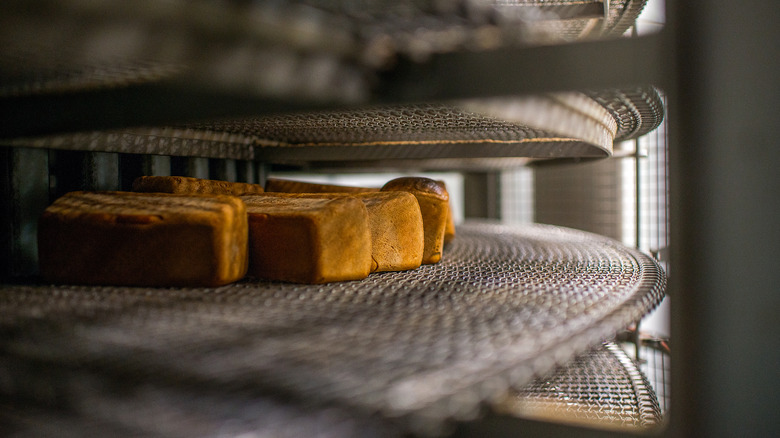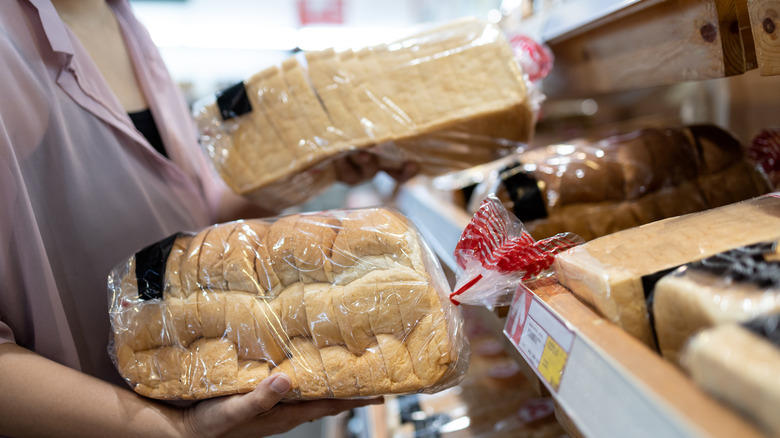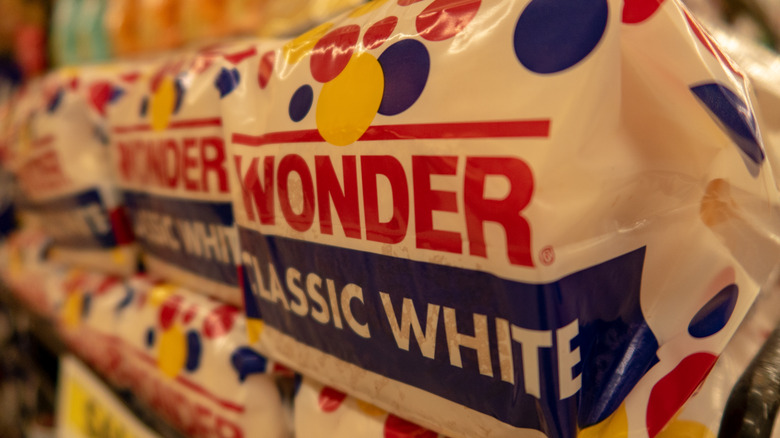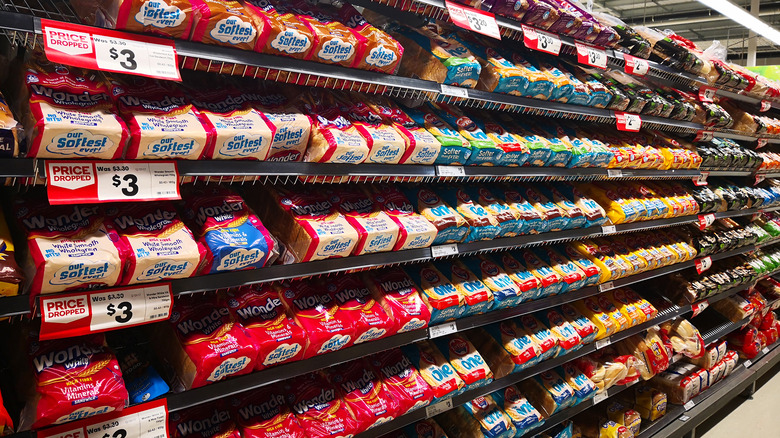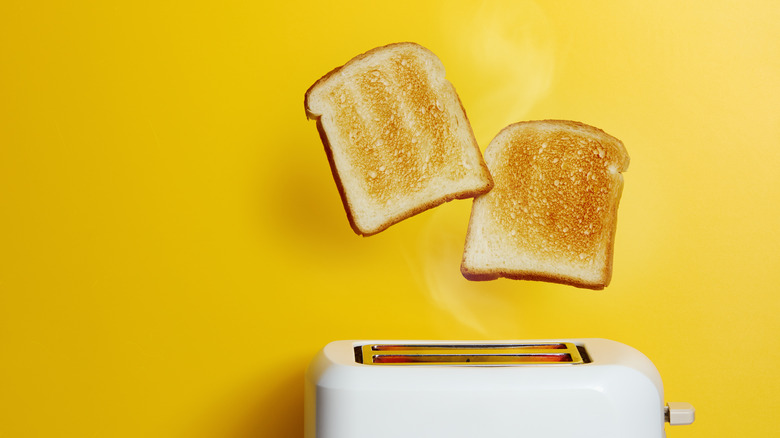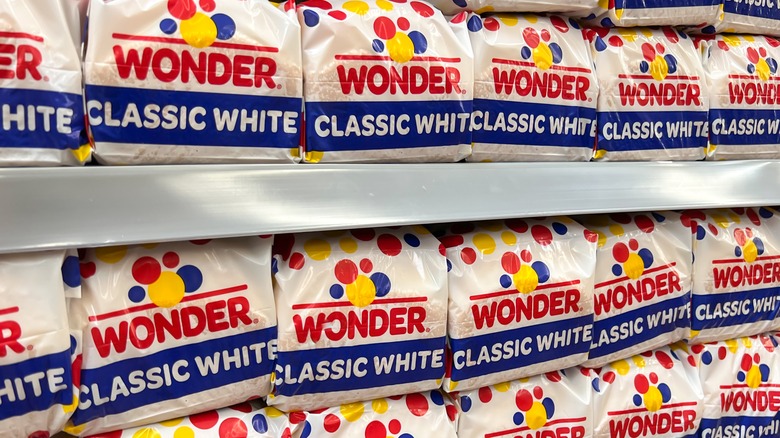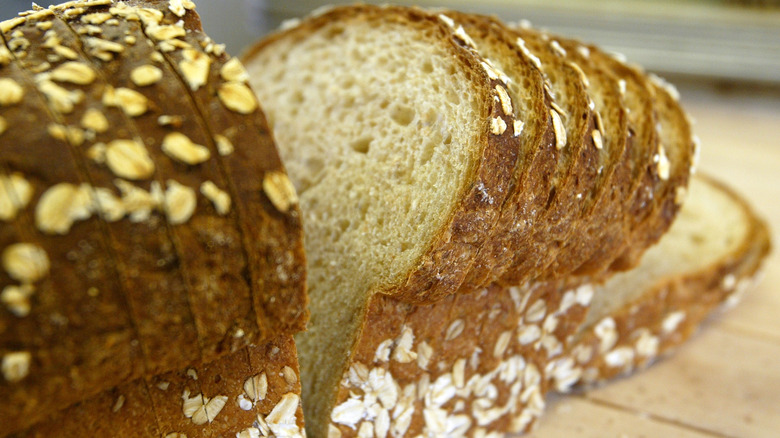The Complete History Of Sliced Bread
The concept of bread is something that has sustained, fueled, and comforted humankind since the Epipaleolithic time. The first evidence of its use, found recently in Jordan, dates back to more than 14,000 years ago (via NPR.) Thankfully, bread has evolved and changed significantly since then, with iterations spanning the globe from the ancient history of pita to injera, chapati Indian flatbread to focaccia.
Bread is a useful commodity for many reasons. It can provide long-lasting energy when made from slow-releasing carbohydrates like whole wheat, corn, and oats. It's also versatile, used like a utensil to scoop up food and allowing for meal portability with bread like tortillas, lavash, or the now ubiquitous sandwich, made from a sliced loaf of leavened bread.
Though John Montague, the 4th Earl of Sandwich, is credited with the portable lunch's name, the concept existed long before his time (via History.com). This process was made a lot easier in more recent history than many may realize with the creation of pre-sliced bread. Commercially sliced bread loaves, which now take up their very own extensive grocery store aisle, have only been around for about 100 years. Here's how the slice of your morning toast, the bread that holds together your lunchtime turkey sandwich or your grilled cheese, found its way to supermarket shelves and onto your plate.
1912: Inventor Otto Rohwedder begins to tinker
Little did Iowa-born Otto Rohwedder know that his invention would lead to the growth and development of an entire food industry. Rohwedder, born July 6, 1880, began his career as a jeweler and entrepreneur, opening several jewelry stores before his shift of focus (via Massachusetts Institute of Technology). By 1912 he had decisively sold all his stores in order to fund his next project. Rohwedder then turned his attention towards building a piece of machinery that would automatically slice an entire loaf of bread at once. Not only did this endeavor include the machinery, but it also focused on the storage and shipment of the bread, keeping the loaves, now divided into slices, fresh and intact.
In 1917 Rohwedder hit his first major stumbling block — a fire broke out in the factories of Rohwedder's first commissioning customers, destroying all existing blueprints, the prototype, and the partnership, leaving Rodwedder with no other choice but to start over.
Serendipitously, after years of rebuilding and refining his idea, Rohwedder received some much-needed assistance from another new invention designed just for bread: the pop-up toaster made its way into the world in 1926. With sliced bread now in demand to being paired with this trendy invention at the forefront of culinary technology, Rohwedder's machinery was more attractive to buyers than ever before. It was a mutually beneficial arrangement for both toaster and sliced bread, each making the other more attractive and appealing for everyday domestic use.
1928: Bread is first sold sliced in Chillicothe, Missouri
The first company to sign onto this new way of working was Frank Bench's Chillicothe Baking Company, creating the product Kleen Maid Sliced Bread and stirring up some newsworthy attention (via Chillicothe Newspaper Archive). Rohwedder's new technology was featured in the Chillicothe Constitution-Tribune, calling the invention both "startling" and "a thrill of pleasure ... a refinement that will receive a hearty and permanent welcome."
Though there was initial concern from customers on how long a pre-sliced loaf of bread would last before going stale, by wrapping the loaves in wax paper to preserve freshness, the concerns were overridden by the ease of use.
After significant research, Rohwedder decided on the most useful thickness of each slice (via History.com). He detailed it as just under half an inch, which would work to showcase the beauty and usefulness of a machine-made slice, promising precision and uniformity, resulting in the perfect width for both sandwiches and toast. This also meant the factory-produced loaves could be made with a softer texture in mind if then pre-sliced before distribution. This gave customers a softer chew, an easier time when used for sandwiches, and a pleasurable experience that was hard to replicate with the harder, crustier homemade loaves.
1928 – 1930: Sliced bread becomes the greatest thing
Rohwedder was not the first to invent bread slicing machinery — earlier versions first appeared in the 1860s (via The Atlantic). However, he was clearly the most successful.
Despite initial concerns about freshness, design, or customer interest, pre-sliced loaves of bread are a huge hit. Bench's Chillicothe Baking Company increased its sales by 2000% in just the first two weeks! Over the next year, Rohwedder receives over 230 new orders for the machinery from across the nation (via Washington Post). This was far more than Rodwedder had ever anticipated, understandably producing a delay between the placement of an order and its fulfillment. Nearby bakeries waiting for a slicing machine order to be fulfilled would often bring loaves to Bench's in hopes of using its machinery to meet the ever-increasing customer demand for a pre-sliced loaf. Though it is just the beginning of bread's rise to the top, or rather, the bottom of the American food pyramid, sales for the pre-sliced good show just how severe the demand has always been for this now daily time-saver. Everybody wants in the sliced bread game.
Later, in 1933, while still in the grips of The Great Depression, Rohwedder would go on to sell his successful patent to a larger company. Considered to be a historic patent, Franks & Co notes, "Rohwedder used his patents to survive the longest, deepest economic crisis in American history" while changing how bread is made, sold, and eaten.
1930: Wonder Bread picks up on the new technology
Though Wonder Bread is often thought to have been the first to hop on the sliced bread train, it wasn't. Though, it wasn't long after the sliced bread craze began that the company wanted in on the action. In 1930 Wonder, owned at the time by the Taggart Baking Company, began selling its signature sliced product. The brand, named after the sense of "wonder" experienced during the International Balloon Race (as well as the balloons' lighter-than-air aesthetics), was also keen to do whatever best promoted the signature soft texture. Pre-slicing just made sense.
Wonder Bread soon became synonymous with a pillowy, squeezable texture, a whiter-than-white appearance, and how it arrived: sliced. Slice bread soon became a staple household item in the U.S. By 1933, it was estimated that 80% of bread sold in America was sold pre-sliced (via Dawn Foods.)
Not only was this trend affecting trade and eating habits, but it also seeped into the American lexicon. Everything was compared to this life-altering invention, creating phrases like "the most progressive step ... in the baking industry since sliced bread" and "the newest thing since sliced bread" (via Metro). And, don't forget the phrase that is still with us today: "the greatest thing since sliced bread," credited to comedian Red Skelton in 1952 for his description of the television set, per The Independent.
1943: The FDA bans the manufacturing of sliced bread
Sliced bread had become a staple product of most American households, marketed especially towards busy housewives and women, many of whom were supporting their families while husbands were away fighting in World War II or were beginning to work outside the home due to war effort requests or financial necessity. By 1943 women-centered efforts, from growing victory gardens to canning and preserving, were often used as propaganda by the U.S. government, correlating the work with a sense of patriotism and civic duty (via Womenshistory.org).
However, despite the growing needs of many women and families to cut down on time in the kitchen, in 1943, at the height of the Second World War, the FDA made the controversial choice to ban sliced bread over concerns of the diverted resources of waxed paper used to wrap the bread and steel used for the machinery. This was not the first time products primarily used or purchased by women were targets of rationing in WWII. The list also included nylon stockings and sugar, suggesting women make a "victory cake" to support war efforts (via Atlas Obscura).
Notably, Wonder Bread was not the only product eventually owned by Hostess Brands that endured war rationing or banning efforts. Hostess Brands Twinkies were also the subject of WWII rationing; the once banana and cream-filled centers forever changed to vanilla when bananas fell under the list of rationed foods.
Less than one week later: there is a call to roll back the ban
Despite its relatively recent history, a loaf of pre-sliced bread had become essential within the family home. The banning of the country's new staple took matters too far. The law was met by outrage both from customers and from companies alike, such as Wonder Bread, whose entire success was largely related to the booming sales of pre-sliced bread.
The upset and uprise opposing the ban on this once-luxury-now-necessity were immediate, with published letters written to the editor of the New York Times stating, " I should like to let you know how important sliced bread is to the morale and saneness of a household ... " One week after the initial announcement, the Mayor of New York, Fiorello LaGuardia, issued a public statement that grandfathered in bakeries that were already using the new technology (via Atlas Obscura).
After heavy pushback by both household and industry, alongside a fear that bread sales would fall in the wake of the upset, the ban was lifted altogether just three months later. Notably, the statement made to the Associated Press merely notes a miscalculation in the demand for wax paper, without any acknowledgment that the brunt of the ban's effect fell primarily on women and bakeries.
Post WWII: Highly processed foods like Wonder Bread become 'fortified after the war
The '30s and '40s were lean years in America, living through The Great Depression (1929 – 1939) followed by The Second World War (1939 – 1945). The time period left many Americans with poor nutrition, even when there was food to put on the table. Nutrient-related diseases like pellagra and beriberi were on the rise, and foods like white bread provided little nutritional value.
In an effort to close the gap of nutrition deficiencies, the FDA turned its attention to white bread manufacturers in what is now known as the "flour hearings" (via Chicago Magazine). With encouragement from the Surgeon General to address these related diseases, brands like Wonder Bread began using technology to "fortify" products. This meant adding back in some of the vitamins stripped out in the wheat bleaching process. Notably, the wording decided upon was "enriched" rather than "restored" to hide the vitamin-stripping process from consumers.
Though these efforts may now feel more like a marketing tool than anything else, there were significant knock-on health benefits as a result. Beriberi and pellagra were practically eliminated — a good result even if achieved through slightly nefarious intentions.
As they say, no good deed goes unadvertised. JSTOR Daily writes that for years, Wonder Bread used these achievements as the base of its marketing campaigns, staking a claim that the bread was actually a healthy food by showcasing the nutritional value of its lighter-than-air product with the slogan "helps build strong bodies 12 ways."
1980s: Sliced white breads begin to fall from grace
Between the 1960s and 1980s, pre-sliced white bread slowly began to shift from the aspirational white, middle-class, suburban family (who ate up to six slices of the stuff daily, per Salon) to the white, lower or working-class population. It's a somewhat surprising twist from its original place on the cutting edge of technology, convenience, and luxury.
This shift was likely to do with the burgeoning rebellion and counterculture now associated with hippies and macrobiotic eating, which were pushing back against many things, including the role and promotion of industrialized foods and the associated negative effects on health.
Simultaneously, the bulk of the U.S. economy began to shift, moving away from the now considered blue-collar manufacturing industry to become grown and sustained by the white-white-collar financial sector followed a value shift, moving away from the uniform, standardized, or industrially manufactured products and towards more aspirational, individual-centered specialty goods (or at least superficially so). Small bakeries that offered unique and diverse products, largely from whole wheat varieties, became the new "Big Bread," with companies like Au Bon Pain or Great Harvest replacing the aspirational role Wonder Bread once played within the suburban marketplace (via HuffPost.) Factory-made white bread was on the outs.
2012: Wonder Bread disappears from supermarket shelves, returning a year later
In 2012, Wonder Bread ghosted U.S. consumers, quietly slipping off the grocery shop shelves. By that time, they were hard pressed to continue relying on the health-led marketing campaign of yesteryears; consumers had wised up to the reality that "enriched" really meant "restoring" the benefits that processing and bleaching wheat worked so hard to remove. Profits reflected the opinions of the informed consumer, with sales now down by 15% with no sign of change.
It was furthered by the folding of Hostess Brands, the former owner of Wonder Bread, resulting in not only removing Wonder Bread from shelves but also being out of production for nearly a year.
Flower Foods Inc. saw this as an opportunity to capitalize on a marketing makeover focused on nostalgia rather than health. They bought the brand, returning Wonder Bread's packaging to its original branding and recipe to help elicit warm, wholesome, and nostalgic feelings associated with "the good old days." The marshmallow-like wonder product returned to shelves in 2013, as reported by CBS News, likely before most consumers realized it had been missing in the first place. It's further proof that the power of ghosting works just as well for products as it does for leaving parties.
Today: What once was old is made new again
Today, much of the bread industry is not as it once was just 100 years ago. Many Wonder Bread factories have since shuttered permanently. Trends and tastes have changed, often reflecting the nutritional information and transparency of practices now available to consumers. However, many of these iconic and historical markers have been given a second life, even if temporarily, or at least an acknowledgment of a place in history.
One closed Wonder Bread factory in Hoboken, New Jersey, has been the target of a second and highly aspirational life. It has since undergone a facelift, and serious renovations turned it into luxury-style loft apartments dubbed "Wonder Lofts."
The likes of Wonder Bread and other highly processed foods also enjoyed a brief moment in the sun in the early 2000s', when items considered low brow became trendy amongst the aspirational white upper-middle class in "an ironic way" with such events like "white trash parties" becoming fashionable. The trend, however, said more about people throwing the parties than the products themselves.
For those interested in seeing the machine that changed the American diet as we know it, visit the Grand River Historical Society Museum in Chillicothe, Missouri, population 9,500 and the home of the sliced bread, to see the very place it got its start (via the National Museum of American History). The device is on loan from the Smithsonian Institution. Or, check out reruns of the long-running quiz show "Jeopardy!", where the birthplace of sliced bread was once a clue.


